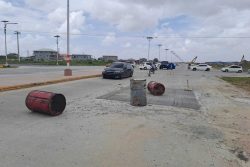There is no doubting that budget 2025 – the sixth presented by this PPP/C administration – contains many measures that the public will welcome. In an election year these include the conclusion of the poorly managed $100,000 cash grant for adults from last year, the expanded Because We Care cash grant for schoolchildren, the lifting of the income tax threshold to $130,000 per month and a cut in the personal income tax rate.
There is also housing which has been a standout feature of PPP/C administrations stretching all the way back to Dr Jagan’s 1992 government.
Among other things Finance Minister Dr Ashni Singh noted that key initiatives over the last four-plus years included:
• Development of 85 new and existing housing areas inclusive of Amelia’s Ward, Balthycock, Belle West, Charity, Cummings Lodge, De Endragt, La Bonne Intention, Lethem, Leonora, No. 75 & 79 Villages, Shieldstown, Success, Williamsburg and York.
• Allocation of over 40,000 house lots across all income categories, and distribution of over 10,000 land titles and transports.
• Completing construction of over 2,000 homes of which 1,193 were low-income, 493 were moderate income and 330 were young professionals.
This is impressive by any account and the only caveat as is the case for many parts of this year’s budget is an examination of the effectiveness of the targets. Of the 40,000 house lots how many of these will actually see work completed before the end of this term? Is there any untoward trading of lots or speculation? One would have thought that by now the Ministry of Housing and Water with all the resources available to it would have been able to supply Minister Singh with a compendium on the effectiveness of the house lot distributions for 2021, 2022 and 2023.
This year’s budget is a stupendous $1.38 trillion, roughly US$6.6b and this figure is also 20.6% higher than last year’s. The key question which the government has to answer is how was last year’s expenditure absorbed into the economy amid human resources and natural resources shortages and is the higher planned expenditure this year appropriate in that light?
Two flagship projects – the new Demerara Harbour Bridge and the Gas to Energy (GtE) project – on which this higher expenditure is expected have encountered several timeframe setbacks including the most ludicrous explanation that concrete works on the bridge needed curing time. It goes with saying that curing would have been gauged for in any well-organised contract. It is more than likely that that the various other shortcomings that affect the economy played into this extended deadline.
To ensure its re-election, the PPP/C was hoping earnestly to have both of these projects in place long before the expected November timeframe for the general elections. It went all out to ensure this by avoiding a purpose-built feasibility study for the GtE, instead relying on all things a mish-mash of studies bequeathed by its arch-rival predecessor, APNU+AFC. The same resource deficiencies now have the government entangled in a US$100m arbitration with the GtE contractors. As for the bridge project, the government refused to permit a needed Environmental and Social Impact Assessment.
In the meanwhile, burdening future governments with what may be unsustainable expenses, President Ali has announced that tolls for all bridges will be free on the commencement of the operation of the New Demerara Harbour Bridge and electricity tariff cuts will be implemented even before the financials of the completed GtE are carefully examined. This is injudiciousness turbo charged and not based on careful planning. This laissez faire approach is evident in many other areas of planned expenditure.
The state has become the subsidizer-in-chief of many industries without considering whether this is leading to enrichment in the private sector to the detriment of the public. The massive expenditure on corn and soybeans is a case in point. This is an important pioneering industry and a significant addition to non-traditional crops. Will this investment by the state be transformed into equity on which dividends will be paid? Will the price of chicken feed result in the lower cost of poultry? Will small rearers still have a portion of the market or will they be muscled out by the big players? There is no evidence of the government addressing these questions in all of the sectors that it constantly intervenes in.
The hundreds of billions of dollars spent on infrastructure has produced many examples of delayed or bad construction leading to cancellation of contracts and worse, the nursing along of persons who have no business being anywhere near such work. It is not only a matter of the corrupt assigning of contracts in the public procurement system but also of the additional cost incurred by having to redo work. This was recently pointed out in relation to Thomas Lands. There is no need again to mention pump station contracts which the Ali government’s procurement board has vulgarly and improperly assigned to the unskilled.
The excessive spending of this government without checks and balances and an examination of the effectiveness of the expenditure will become a recurring issue. No one should ignore the fact that the publicly guaranteed debt as of the end of last year was a whopping US$5.993b, 167% higher than at the end of 2023 and verging on triple what Guyana’s longstanding and onerous debt burden was in the 80’s and 90’s. Indeed, the country clearly has a much better ability to repay this debt which will however continue to depend on the draining of the Natural Resource Fund to the detriment of inter-generational equity. That is apparently of little concern to the government or the PPP.
It is shocking that the government will sink another huge sum into the sugar industry without accounting for its continuing failure. The government has only reopened the Rose Hall Estate. Its promise in relation to the East Demerara and Skeldon estates will not materialise. Meanwhile, the cost per pound of sugar continues to be astronomic and unsustainable at the moment. When last was any sugar sold overseas? And at what price per pound?
It was quite interesting that Minister Singh’s lengthy presentation was bereft of the slightest mention of the ludicrous assertion by President Ali that more than 50,000 jobs have been created. What was however noted in the budget is that the government will expand its de facto unemployment programme to the so-called 10-day workers. Has there been an examination of the type of service provided by these workers over the 10 days?
There is much more that can be said about this budget but the focus will now shift to parliament. Minister Singh’s repetitive declamations against the APNU+ AFC administration were completely uncalled for but underlined whether by instruction or upon his own initiative that this government, notwithstanding the prating about ‘One Guyana’, has no interest in creating a salubrious environment for discussions on matters such as the oil economy and a post oil economy with the opposition. Only the PPP/C and its friends in the private sector apparently have any purchase on such issues.
So what is the opposition to do? For starters it needs to begin earning its keep and the public will be able to gauge whether or not it is prepared for this task on Friday or at all. The “debate” on the budget should really be cut to one day and permit 10 speakers from each side precisely 10 minutes to say what they have to say before the beginning of the consideration of the estimates. Has the opposition done any substantial work in tracking the huge amount of expenditure last year or will it simply engage in banter and scandal that is unfounded? It has about a week to get itself together. Members of the public face the worst of two worlds: a government that is hardly accountable and an opposition that shows no evidence of hard work.
In his introduction to the budget, Minister Singh spoke about prosperity.
“…we have today our best ever opportunity to achieve real and lasting prosperity. As we harness our vast endowment of natural resources, our duty and our commitment to the Guyanese People is that the country’s resources will be managed and mobilised in such a way as to ensure that national prosperity results in community, household, and individual prosperity. Consequently, as previously explained in Budget 2024, our aim is to ensure that every single Guyanese family is able, not only to meet all of their most basic needs but also, to accumulate household and personal wealth through their own efforts”.
Perhaps Minister Singh should re-read the more than 100 instalments of the Stabroek News cost of living series, more than 1,000 heartfelt testimonies from all across the country on how families are struggling to make a living in oil-rich Guyana.









